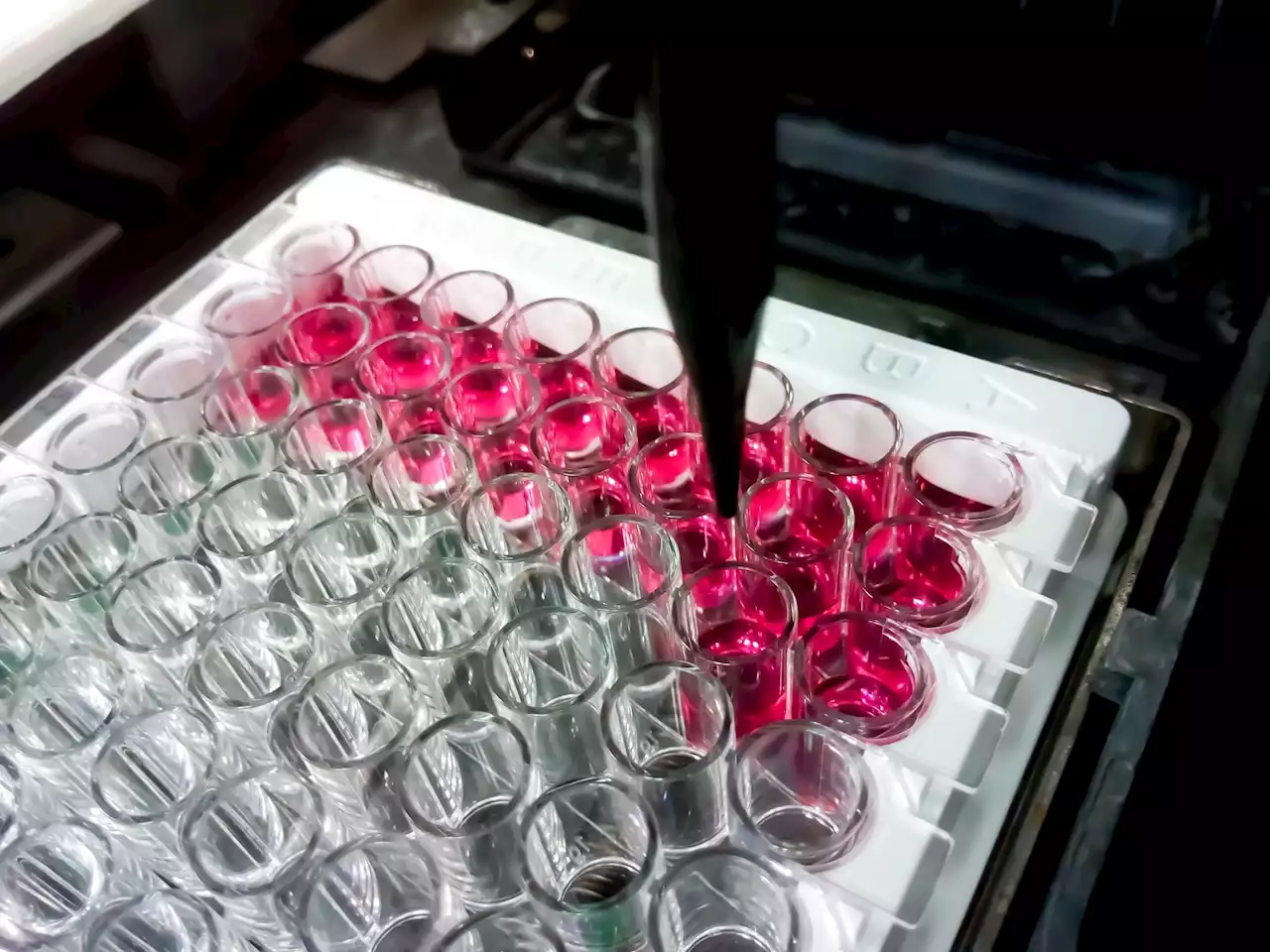Monoclonal antibody-based blocking ELISA for SARS-CoV-2 detection in animals Antibody ELISA Monoclonal Antibody SARSCoV2 Coronavirus Disease COVID UofIllinois Cornell biorxivpreprint
By Bhavana KunkalikarMar 16 2023Reviewed by Danielle Ellis, B.Sc. *Important notice: bioRxiv publishes preliminary scientific reports that are not peer-reviewed and, therefore, should not be regarded as conclusive, guide clinical practice/health-related behavior, or treated as established information.
About the study In the present study, researchers described the generation of a blocking ELISA based on monoclonal antibodies to identify SARS-CoV-2 exposure among animals. SARS-CoV-2 was experimentally introduced into a group of 24 cats. Cat serum samples were collected 14 days after infection and were combined to create a group of positive control serums. Also, large volumes of negative cat sera were combined to create a single batch of negative control serum. To investigate the diagnostic sensitivity as well as specificity associated with mAb-based bELISA, the team evaluated a panel of blood samples from cats, ferrets, minks, and deer with known antibody status.
United Kingdom Latest News, United Kingdom Headlines
Similar News:You can also read news stories similar to this one that we have collected from other news sources.
 Research highlights the potential risk of secondary SARS-CoV-2 transmission from wild ratsIn a recent study published in the journal mBio, researchers in the United States evaluated rat exposure to severe acute respiratory syndrome coronavirus 2 (SARS-CoV-2) in New York City (NYC).
Research highlights the potential risk of secondary SARS-CoV-2 transmission from wild ratsIn a recent study published in the journal mBio, researchers in the United States evaluated rat exposure to severe acute respiratory syndrome coronavirus 2 (SARS-CoV-2) in New York City (NYC).
Read more »
 Examining SARS-CoV-2 origin theoriesA recent study published in the Journal of Virology summarized the evidence on severe acute respiratory syndrome coronavirus 2 (SARS-CoV-2) origin hypotheses.
Examining SARS-CoV-2 origin theoriesA recent study published in the Journal of Virology summarized the evidence on severe acute respiratory syndrome coronavirus 2 (SARS-CoV-2) origin hypotheses.
Read more »
 Jiang Yanyong: Whistleblower doctor who exposed China's Sars cover-up diesJiang Yanyong became a national hero after revealing Beijing was covering up the scale of the virus.
Jiang Yanyong: Whistleblower doctor who exposed China's Sars cover-up diesJiang Yanyong became a national hero after revealing Beijing was covering up the scale of the virus.
Read more »
 A novel pan-sarbecovirus vaccine candidate neutralizes Omicron BQ.1.1 and XBB subvariantsA novel pan-sarbecovirus vaccine candidate neutralizes Omicron BQ.1.1 and XBB subvariants Coronavirus Disease COVID Omicron Vaccine SARSCoV2 BQ11 XBB PNASNews
A novel pan-sarbecovirus vaccine candidate neutralizes Omicron BQ.1.1 and XBB subvariantsA novel pan-sarbecovirus vaccine candidate neutralizes Omicron BQ.1.1 and XBB subvariants Coronavirus Disease COVID Omicron Vaccine SARSCoV2 BQ11 XBB PNASNews
Read more »
 Organization of self-advantageous niche by neural stem/progenitor cells during development via autocrine VEGF-A under hypoxia - Inflammation and RegenerationBackground Tissue stem cells are confined within a special microenvironment called niche. Stem cells in such a niche are supplied with nutrients and contacted by other cells to maintain their characters and also to keep or expand their population size. Besides, oxygen concentration is a key factor for stem cell niche. Adult neural stem/progenitor cells (NSPCs) are known to reside in a hypoxic niche. Oxygen concentration levels are lower in fetal organs including brain than maternal organs. However, how fetal NSPCs adapt to the hypoxic environment during brain development, particularly before pial and periventricular vessels start to invade the telencephalon, has not fully been elucidated. Methods NSPCs were prepared from cerebral cortices of embryonic day (E) 11.5 or E14.5 mouse embryos and were enriched by 4-day incubation with FGF2. To evaluate NSPC numbers, neurosphere formation assay was performed. Sparsely plated NSPCs were cultured to form neurospheres under the hypoxic (1% O2) or normoxic condition. VEGF-A secreted from NSPCs in the culture medium was measured by ELISA. VEGF-A expression and Hif-1a in the developing brain was investigated by in situ hybridization and immunohistochemistry. Results Here we show that neurosphere formation of embryonic NSPCs is dramatically increased under hypoxia compared to normoxia. Vegf-A gene expression and its protein secretion were both up-regulated in the NSPCs under hypoxia. Either recombinant VEGF-A or conditioned medium of the hypoxic NSPC culture enhanced the neurosphere forming ability of normoxic NSPCs, which was attenuated by a VEGF-A signaling inhibitor. Furthermore, in the developing brain, VEGF-A was strongly expressed in the VZ where NSPCs are confined. Conclusions We show that NSPCs secret VEGF-A in an autocrine fashion to efficiently maintain themselves under hypoxic developmental environment. Our results suggest that NSPCs have adaptive potential to respond to hypoxia to organize self-advantageous niche invo
Organization of self-advantageous niche by neural stem/progenitor cells during development via autocrine VEGF-A under hypoxia - Inflammation and RegenerationBackground Tissue stem cells are confined within a special microenvironment called niche. Stem cells in such a niche are supplied with nutrients and contacted by other cells to maintain their characters and also to keep or expand their population size. Besides, oxygen concentration is a key factor for stem cell niche. Adult neural stem/progenitor cells (NSPCs) are known to reside in a hypoxic niche. Oxygen concentration levels are lower in fetal organs including brain than maternal organs. However, how fetal NSPCs adapt to the hypoxic environment during brain development, particularly before pial and periventricular vessels start to invade the telencephalon, has not fully been elucidated. Methods NSPCs were prepared from cerebral cortices of embryonic day (E) 11.5 or E14.5 mouse embryos and were enriched by 4-day incubation with FGF2. To evaluate NSPC numbers, neurosphere formation assay was performed. Sparsely plated NSPCs were cultured to form neurospheres under the hypoxic (1% O2) or normoxic condition. VEGF-A secreted from NSPCs in the culture medium was measured by ELISA. VEGF-A expression and Hif-1a in the developing brain was investigated by in situ hybridization and immunohistochemistry. Results Here we show that neurosphere formation of embryonic NSPCs is dramatically increased under hypoxia compared to normoxia. Vegf-A gene expression and its protein secretion were both up-regulated in the NSPCs under hypoxia. Either recombinant VEGF-A or conditioned medium of the hypoxic NSPC culture enhanced the neurosphere forming ability of normoxic NSPCs, which was attenuated by a VEGF-A signaling inhibitor. Furthermore, in the developing brain, VEGF-A was strongly expressed in the VZ where NSPCs are confined. Conclusions We show that NSPCs secret VEGF-A in an autocrine fashion to efficiently maintain themselves under hypoxic developmental environment. Our results suggest that NSPCs have adaptive potential to respond to hypoxia to organize self-advantageous niche invo
Read more »
 Toddler fighting for life after horrifying eight-storey fall from block of flats in SurreyA toddler was rushed to hospital with life-threatening injuries after plunging eight storeys from a flat in Surrey.
Toddler fighting for life after horrifying eight-storey fall from block of flats in SurreyA toddler was rushed to hospital with life-threatening injuries after plunging eight storeys from a flat in Surrey.
Read more »
